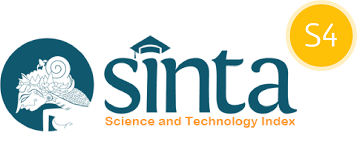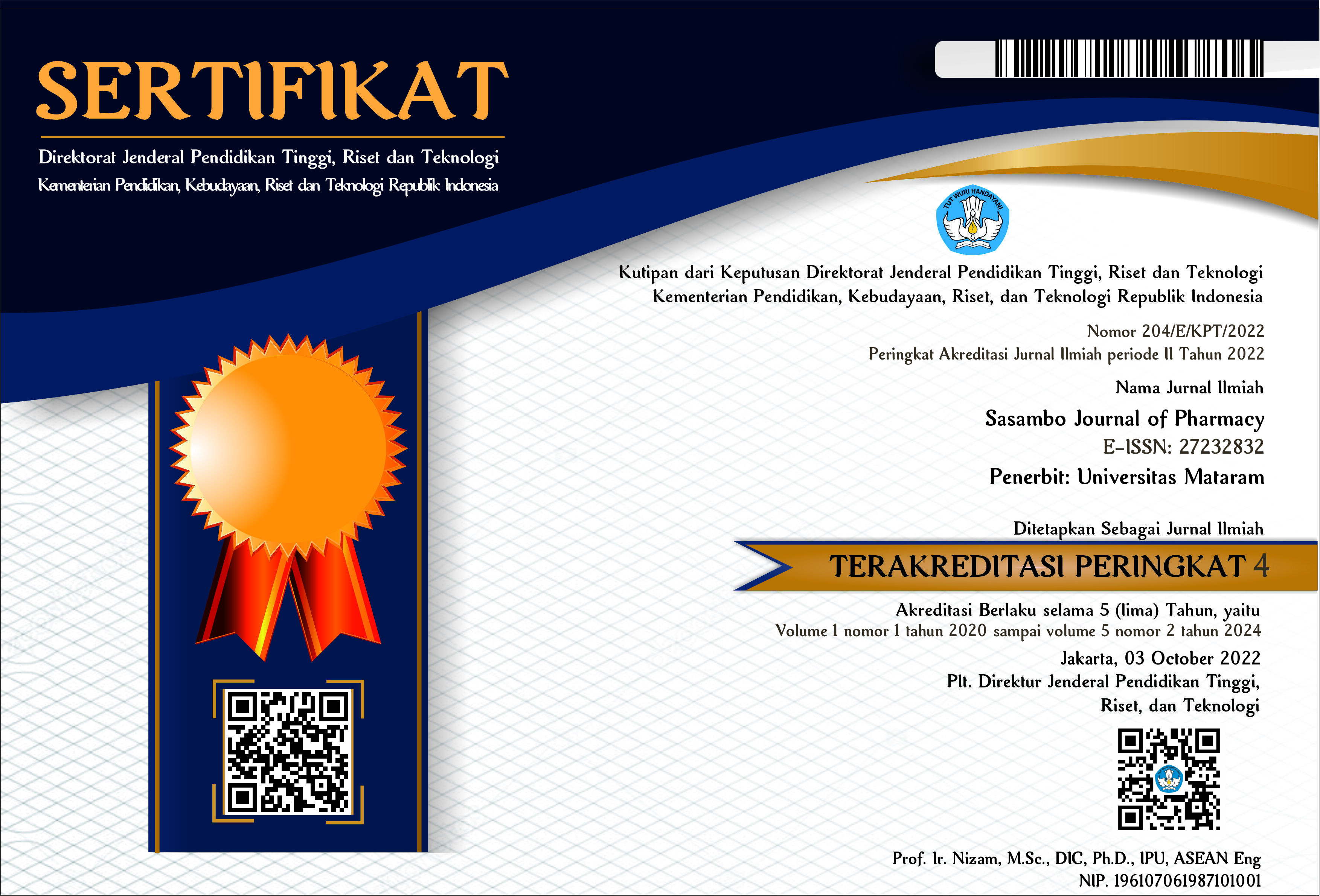Formulasi dan Evaluasi Sifat Fisik Lotion Ekstrak Etanol Daun Kemuning (Murraya paniculata (L) Jack) dan Daun Lidah Buaya (Aloe vera Linn)
DOI:
10.29303/sjp.v1i1.6Downloads
Abstract
The ultraviolet radiation and skin water loss could damage the skin. Kemuning leaves (Murraya paniculata (L) Jack) as a source of anti-oxidants and Aloe vera leaves (Aloe vera Linn) can prevent this action. This study aims to formulate and evaluate lotion containing the Kemuning leaves and Aloe vera extract. The extract of Kemuning leaves was obtained by sonication using 70% ethanol solvent. Aloe vera juice was obtained by smoothing the aloe vera gel then filtered using clean gauze. The kemuning leaves extract and aloe vera extract had formulated into lotion preparation. The physical properties of the lotion (homogeneity, type of emulsion, pH, spreadability, and adhesion) were determined. The organoleptic test showed that the color of the lotion was pale yellow with a smooth texture and had extract scent. The lotion was showed good homogeneity, spreadability 7.31 cm, pH 7, type oil in water and adhesion 45 seconds. The physical properties parameters of lotion preparations showed that the lotion preparations had fulfilled the requirements of good preparations.Keywords:
Kemuning leaves, Aloe vera leaves, LotionReferences
Aulton, M. E. (2001). Pharmaceutics: The science of dosage form design. Pharmaceutics: The science of dosage form design. https://doi.org/10.1016/0168-3659(89)90050-3
Azlia, K., Syazili, A., Syahrul, M., & Nasution, H. (2019). Review Efek Antioksidan pada Kemuning ( Murraya paniculata ( L .) Jack ) Review of Antioxidant Activity of Kemuning ( Murraya paniculata ( L .) Jack ). Majority, 8, 265–272.
Barel, A. O., Paye, M., & Maibach, H. I. (2001). Handbook Of Cosmetic Science and Technology. New York: Marcel Dekker.
Bhuvana, K. B., Hema, N. G., & Patil, R. T. (2014). Review on aloe vera. International Journal of Advanced Research, 2(3), 677–691.
Buah, E., Solanum, T., & Candida, T. (2017). Jurnal Riset Sains dan Teknologi, 1(1), 15–21.
Duggin, G. (1996). Softening Skin with Emollient Ingredients. In Manufacturing Chemist (pp. 27–31).
Garg, A., Aggarwal, D., Garg, S., & Singla, A. K. (2002). Spreading of Semisolid Formulations. Pharmaceutical Technology, (September).
Helfrich, Y., Sachs, D., & Voorhees, J. (2008). Overview of skin aging and photoaging. Dermatol Nurs, 20(3).
Jones, D. (2008). Pharmaceutics – Dosage Form and Design. London: Pharmaceutical Press.
Kanwar, A. . (2018). Skin barrier function. The Indian Journal of Medical Research, 147(1).
Lambers, H., Piessens, S., Bloem, A., Pronk, H., & Finkel, P. (2017). Natural skin surface pH Is on average below 5 , which is beneficial for its resident flora Natural skin surface pH is on average below 5 , which is beneficial for its resident flora. International Journal of Cosmetic Science, (November 2006). https://doi.org/10.1111/j.1467-2494.2006.00344.x
Lieberman, A. H. (1998). Pharmaceutical Dosage Form, Disperse System. Philadelphia: Marcel Dekker.
Poljˇsak, B., & Dahmane, R. (2012). Free Radicals and Extrinsic Skin Aging. Dermatology Research and Practice, 2012. https://doi.org/10.1155/2012/135206
Pujiastuti, A., & Kristiani, M. (2019). Formulasi dan Uji Stabilitas Mekanik Hand and Body Lotion Sari Buah Tomat ( Licopersicon esculentum Mill .) sebagai Antioksidan Formulation and Mechanical Stability Test for Hand and Body Lotionfrom Tomato Juice ( Licopersiconesculentum Mill .) as Antioxi. Jurnal Farmasi Indonesia, 16(1), 42–55.
Sharma, P., Kharkwal, A., Kharkwal, H., & Abdin, M. Z. (2014). A Review on Pharmacological Properties of Aloe vera. International Journal of Pharmaceutical Sciences Review and Research, (December).
Sholihah, M., Ahmad, U., & Budiastra, I. wayan. (2017). Aplikasi Gelombang Ultrasonik untuk Meningkatkan Rendemen Ekstraksi dan Efektivitas Antioksi dan Kulit Manggis Application. Jurnal Keteknikan Pertanian, 5(2), 161–168.
Stojiljkovi, D., Pavlovi, D., & Arsi, I. (2014). Oxidative Stress , Skin Aging and Antioxidant Therapy, 31(4), 207–217. https://doi.org/10.2478/afmnai-2014-0026
License
Authors who publish with Sasambo Journal of Pharmacy (SJP), agree to the following terms:
- Authors retain copyright and grant the journal right of first publication with the work simultaneously licensed under a Lisensi Creative Commons Atribusi 4.0 Internasional. This license allows authors to use all articles, data sets, graphics and appendices in data mining applications, search engines, web sites, blogs, and other platforms by providing an appropriate reference. The journal allows the author(s) to hold the copyright without restrictions and will retain publishing rights without restrictions.
- Authors are able to enter into separate, additional contractual arrangements for the non-exclusive distribution of the journal's published version of the work (e.g., post it to an institutional repository or publish it in a book), with an acknowledgment of its initial publication in Sasambo Journal of Pharmacy
- Authors are permitted and encouraged to post their work online (e.g., in institutional repositories or on their website) prior to and during the submission process, as it can lead to productive exchanges, as well as earlier and greater citation of published work (See The Effect of Open Access).







